การใช้ No Not
ในภาษาไทยใช้คำว่า “no not” เพื่อแสดงคำปฏิเสธหรือการไม่เห็นด้วยกับเรื่องที่กล่าวถึง ซึ่งมีบทบาทที่หลากหลายในประโยคต่างๆ ดังนี้คือ:
1. การใช้ “no not” เพื่อแสดงคำปฏิเสธในประโยคบอกรอบ
เมื่อเราต้องการปฏิเสธประโยคที่มีคำกริยาอยู่แล้ว เราสามารถใช้ “no not” เพื่อแสดงความปฏิเสธหรือการไม่เห็นด้วยต่อประโยคนั้นได้ เช่น:
– He did not go to the party. (เขาไม่ไปงานค่ะ)
– She does not like coffee. (เธอไม่ชอบกาแฟค่ะ)
2. การใช้ “no not” เพื่อแสดงคำปฏิเสธในประโยคคำถาม
ในกรณีที่มีการถามคำถามและต้องการปฏิเสธหรือไม่เห็นด้วยกับคำตอบ เราสามารถใช้ “no not” เพื่อแสดงคำปฏิเสธนั้นได้ เช่น:
– Did you see the movie last night? No, I did not. (คุณดูหนังเมื่อคืนไหมคะ? ไม่ค่ะ ฉันไม่ได้ดู)
– Have you ever been to Japan? No, I have not. (คุณเคยไปญี่ปุ่นมาก่อนไหมคะ? ไม่ค่ะ ฉันยังไม่เคยไป)
3. การใช้ “no not” เพื่อแสดงคำปฏิเสธในประโยคของเรื่องที่ไม่แน่ใจ
เมื่อเราต้องการแสดงความไม่แน่ใจหรือการปฏิเสธในเรื่องที่ยังไม่แน่ใจ เราสามารถใช้ “no not” ในประโยคนั้นๆ เช่น:
– Are you sure he is not coming to the party? (คุณแน่ใจใช่ไหมว่าเขาจะไม่มางานค่ะ?)
– I am not certain that it will not rain tomorrow. (ฉันไม่แน่ใจว่าพรุ่งนี้จะไม่ฝนค่ะ)
4. การใช้ “no not” เพื่อแสดงคำปฏิเสธในประโยคแบบสมาธิ
เมื่อเราต้องการแสดงคำปฏิเสธในประโยคที่พูดอยู่ โดยให้ผู้ฟังมีความเป็นสมาธิ เราสามารถใช้ “no not” เพื่อเน้นคำปฏิเสธนั้นได้ เช่น:
– No, I do not want any more cake. (ไม่ค่ะ ฉันไม่อยากได้อีกแล้ว)
– No, I am not interested in joining the club. (ไม่ค่ะ ฉันไม่สนใจที่จะเข้าร่วมชมรม)
5. การใช้ “no not” เพื่อแสดงคำปฏิเสธในประโยคเปรียบเทียบ
เรายังสามารถใช้ “no not” เพื่อแสดงคำปฏิเสธในประโยคที่เปรียบเทียบได้ เช่น:
– This dress is not as expensive as that one. (เดรสนี้ไม่แพงเท่าเดิมค่ะ)
– The weather today is not as hot as yesterday. (อากาศวันนี้ไม่ร้อนเท่าวานค่ะ)
6. การใช้ “no not” เพื่อแสดงคำปฏิเสธในประโยคของการถามกับกฎหมาย
ในกรณีที่มีคำถามที่เกี่ยวข้องกับกฎหมาย และต้องการแสดงคำปฏิเสธหรือไม่เห็นด้วยเกี่ยวกับกฎหมายนั้น เราสามารถใช้ “no not” เพื่อแสดงคำปฏิเสธนั้นได้ เช่น:
– Do you agree to the terms and conditions? No, I do not. (คุณเห็นด้วยกับเงื่อนไขตามที่กำหนดมารึเปล่าคะ? ไม่ค่ะ ฉันไม่เห็นด้วย)
– Are you aware of the law? No, I am not. (คุณรู้จักกฎหมายหรือไม่คะ? ไม่ค่ะ ฉันไม่รู้จัก)
7. การใช้ “no not” เพื่อแสดงคำปฏิเสธในประโยคที่เกี่ยวข้องกับข้อความ
เรายังสามารถใช้ “no not” เพื่อแสดงคำปฏิเสธในประโยคที่เกี่ยวข้องกับข้อความ เช่น:
– No, I did not receive any message from her. (ไม่ค่ะ ฉันไม่ได้รับข้อความจากเธอเลยค่ะ)
– No, I have not read the book yet. (ไม่ค่ะ ฉันยังไม่ได้อ่านหนังสือเล่มนั้นค่ะ)
การใช้ “no not” เพื่อเน้นคำตามด้วย “not” ในประโยค
เมื่อเราต้องการเน้นคำปฏิเสธในประโยค เราสามารถใช้ “no” ตามด้วย “not” เพื่อเน้นคำปฏิเสธนั้นได้ เช่น:
– No, I do not want to go with you. (ไม่ค่ะ ฉันไม่อยากไปกับคุณ)
– No, I will not be able to come tomorrow. (ไม่ค่ะ ฉันจะไม่สามารถมาพรุ่งนี้ได้)
การใช้ “no” ตามด้วย “noun”
ในกรณีที่ต้องการใช้ “no” กับ “noun” เราใช้ “no” เพื่อแสดงคำปฏิเสธหรือการไม่มีอยู่ของสิ่งนั้นๆ เช่น:
– No, there is no coffee left. (ไม่ค่ะ กาแฟหมดแล้ว)
– No, I do not have any money. (ไม่ค่ะ ฉันไม่มีเงินเลย)
การใช้ “not have”
เมื่อเราต้องการแสดงคำปฏิเสธในประโยคที่มีคำกริยา “have” เราสามารถใช้ “not have” เพื่อแสดงคำปฏิเสธนั้นได้ เช่น:
– No, I do not have time to go shopping. (ไม่ค่ะ ฉันไม่มีเวลาไปช้อปปิ้ง)
– No, I have not had breakfast yet. (ไม่ค่ะ ฉันยังไม่ได้ทานอาหารเช้า)
FAQs
1. “No” แปลว่าอะไร?
คำว่า “no” ในภาษาไทยแปลว่า “ไม่” หรือ “ไม่ใช่” ในบางครั้งอาจใช้เป็นคำตอบปฏิเสธหรือการไม่เห็นด้วยกับคำถามด้วย
2. การใช้ “none” เหมือนกับการใช้ “no not” หรือไม่?
คำว่า “none” เป็นคำจำกัดความของ “no” ที่แสดงถึงไม่มีอยู่เลยหรือไม่มีเลย เราสามารถใช้ “none” เพื่อแสดงคำปฏิเสธนั้นได้ เช่น “None of them can come to the party.” (ไม่มีคนใดมางานค่ะ)
แต่ในบางครั้ง เราอาจใช้ “no not” เพื่อระบุความปฏิเสธอย่างชัดเจนยิ่งขึ้น
3. “Not be” คืออะไร?
“Not be” เป็นการวิเคราะห์กริยาที่แสดงถึงคำปฏิเสธในช่วงปัจจุบัน เช่น “She is not here.” (เธอไม่อยู่ที่นี่)
4. “Is not” และ “are not” คืออะไร?
“Is not” เป็นการวิเคราะห์กริยาที่แสดงถึงคำปฏิเสธในช่วงปัจจุบันของกริยาช่องที่หนึ่ง (หน่วยสิบสอง) เช่น “He is not working today.” (เขาไม่ไปทำงานวันนี้)
“Are not” เป็นการวิเคราะห์กริยาที่แสดงถึงคำปฏิเสธในช่วงปัจจุบันของกริยาช่องที่สอง (หน่วยพหูพจน์) เช่น “They are not coming with us.” (พวกเขาไม่มากับพวกเรา)
การใช้ “no not” เพื่อแสดงคำปฏิเสธมีบทบาทสำคัญในภาษาไทย ซึ่งการนำมาใช้ในประโยคต่างๆ ช่วยให้เราสามารถแสดงความไม่เห็นด้วยหรือคำปฏิเสธในรูปของประโยคที่ต้องการได้อย่างชัดเจน ถ้าหากใช้คำนี้อย่างถูกต้อง จะช่วยให้คุณสื่อสารได้อย่างเป็นระบบและเข้าใจได้ง่ายขึ้น
No กับ Not มีวิธีใช้ต่างกันยังไง? (เข้าใจง่ายมาก) I Krupann Official
คำสำคัญที่ผู้ใช้ค้นหา: การใช้ no not no ตามด้วย noun, การใช้ not have, No กับ Not, no แปลว่า, การใช้ none, Not be คือ, Is not, Are not
รูปภาพที่เกี่ยวข้องกับหัวข้อ การใช้ no not

หมวดหมู่: Top 61 การใช้ No Not
ดูเพิ่มเติมที่นี่: phauthuatdoncam.net
No ตามด้วย Noun
The basic structure of “no ตามด้วย noun” is fairly straightforward. “No” is a Thai word meaning “or” or “and.” It serves as a connector and is followed by “ตามด้วย” which means “followed by,” and finally, the noun that complements the structure. This structure allows for the combination of multiple items or actions in a sentence, resulting in a unified and coherent message.
The primary function of “no ตามด้วย noun” is to connect two or more nouns or noun phrases together. It enables Thai speakers to list items, qualities, or actions in a natural and concise manner. For example, let’s consider the sentence “I like to eat apples and bananas.” In Thai, we can express this using “no ตามด้วย noun” as “ผมชอบกินแอปเปิ้ล no กล้วย.” Here, “ผมชอบกินแอปเปิ้ล” means “I like to eat apples,” and “กล้วย” means “bananas.” The structure “no กล้วย” acts as the connector, linking the two nouns together into a coherent sentence.
The usage of “no ตามด้วย noun” is not limited to combining nouns alone. It can also be used to link adjectives, adverbs, verbs, or even whole sentences. This flexibility allows Thai speakers to express a wide range of thoughts and ideas. For instance, “เขาเชื่องหมาย no ร่าเริงตลอดเวลา” translates to “He is cheerful and jovial all the time.” Here, “เขาเชื่องหมาย” means “He is cheerful,” and “ร่าเริงตลอดเวลา” means “jovial all the time.” The “no” structure effectively combines the adjectives, providing a complete description in a single sentence.
Interestingly, “no ตามด้วย noun” can also be employed to express commands or instructions. It allows for a concise and straightforward manner of giving directions. For example, “ต่อไป no เลี้ยวซ้าย” means “Next, turn left.” Here, “ต่อไป” means “next,” and “เลี้ยวซ้าย” means “turn left.” By using the “no” structure, this command becomes more streamlined and easily understood.
Now, let’s address some frequently asked questions about “no ตามด้วย noun” to provide further clarity:
Q: Can I use “no ตามด้วย noun” to combine more than two items?
A: Absolutely! The structure “no ตามด้วย noun” can be used to combine any number of items or actions. Whether it’s two, three, or even more, the “no” connector allows for a seamless integration of multiple elements.
Q: Can I use “no ตามด้วย noun” to connect two complete sentences?
A: Yes, you can! “No ตามด้วย noun” is versatile enough to connect complete sentences. It acts as a cohesive tool, joining multiple thoughts and ideas into a single sentence.
Q: Are there any rules for the placement of “no ตามด้วย noun” within a sentence?
A: In Thai, the preferred placement of “no ตามด้วย noun” is immediately after the item or action it follows. However, in certain cases, it can be placed at the beginning of the sentence for emphasis. It is important to note that Thai sentence structure is flexible, allowing for variations in word order.
Q: Are there any exceptions or limitations when using “no ตามด้วย noun”?
A: While “no ตามด้วย noun” is a highly versatile structure, it may not be suitable for all situations. It is recommended to use it when listing items or actions of similar importance or relevance. If the items or actions differ significantly, a different linguistic structure might be more appropriate.
In conclusion, “no ตามด้วย noun” is a powerful grammatical structure in the Thai language that facilitates concise and effective communication. Its ability to combine various elements in a sentence makes it a valuable tool for Thai speakers. By understanding and utilizing this structure, communication in Thai becomes clearer, more organized, and more efficient.
การใช้ Not Have
ในภาษาไทยมีคำแปลของ “not have” ที่ใช้แสดงความไม่มีอยู่ หรือความเป็นตรงข้ามกับการมีอยู่ อย่างไรก็ตาม การใช้ “not have” ในภาษาไทยสามารถทำได้ทั้งในรูปกาลเผ่าเธอกาลและรูปกาลเอกมัย ในบทความนี้เราจะศึกษาการใช้ “not have” ในทั้งสองรูปกาลดังกล่าว รวมถึงตัวอย่างของประโยคที่เกี่ยวข้อง เพื่อให้คุณเข้าใจและสามารถนำไปใช้ในการสื่อสารภาษาไทยได้อย่างถูกต้อง
รูปกาลเผ่าเธอกาล
ในรูปกาลเผ่าเธอกาล เมื่อเราต้องการแสดงความไม่มีอยู่ เราสามารถใช้คำฝังได้ดังตัวอย่างต่อไปนี้:
1. ไม่มี (mai mee): เป็นคำศัพท์ที่ใช้บ่อยที่สุดเพื่อแสดงความไม่มีอยู่ เช่น “ฉันไม่มีเงิน” (chan mai mee ngern) หมายความว่า “I don’t have money” หรือ “ฉันไม่มีเวลา” (chan mai mee wela) หมายความว่า “I don’t have time”
2. ไม่มีอะไร (mai mee a-rai): เมื่อต้องการแสดงความไม่มีสิ่งใดสิ่งหนึ่ง เราสามารถใช้คำว่า “ไม่มีอะไร” ดังตัวอย่าง “เขาไม่มีอะไรทำ” (kao mai mee a-rai tum)
3. ไม่มีใคร (mai mee khrai): เมื่อต้องการแสดงความไม่มีใครอยู่ เราสามารถใช้คำว่า “ไม่มีใคร” เช่น “เราไม่มีใครช่วย” (rao mai mee khrai chuay)
คำนี้ใช้ในทั้งรูปกาลปัจจุบัน อดีต และอนาคตเหตุการณ์ ตัวอย่างเช่น “ฉันไม่มีเวลา” (chan mai mee wela) หมายความว่า “I don’t have time” หรือ “ฉันไม่มีเงิน” (chan mai mee ngern) หมายความว่า “I don’t have money”
รูปกาลเอกมัย
ในรูปกาลเอกมัย เราสามารถใช้คำแทนกันได้ โดยเริ่มจากคำว่า “ไม่มี” (mai mee) ตามด้วยการใช้รูปใหม่ของคำกริยาแบบเอกษร เช่น:
1. ไม่มีการทำ (mai mee gaan tham): เราสามารถใช้คำนี้เมื่อต้องการบอกว่าไม่มีการกระทำเกิดขึ้น เช่น “เขาไม่มีการทำงาน” (kao mai mee gaan tham ngaan)
2. ไม่มีการพบ (mai mee gaan phop): เมื่อต้องการแสดงความไม่มีเหตุการณ์ใดเหตุการณ์หนึ่งเกิดขึ้น เราสามารถใช้คำนี้ได้ เช่น “วันนี้ไม่มีการพบปะกัน” (wan nee mai mee gaan phop bpa gan)
3. ไม่มีการเปลี่ยนแปลง (mai mee gaan bpliian-plaeng): ในกรณีที่เราต้องการบอกว่าไม่มีการเปลี่ยนแปลงเกิดขึ้น เราสามารถใช้คำว่า “ไม่มีการเปลี่ยนแปลง” เช่น “สถานการณ์ยังไม่มีการเปลี่ยนแปลง” (sathanakaarn yang mai mee gaan bpliian-plaeng)
เราสามารถใช้ “not have” ทั้งในประโยคบอกเหตุการณ์ และประโยคบอกบุคคล เช่น:
– ตอนนี้เธอไม่มีเวลา (dtawn nee tur mai mee wela) หมายความว่า “She doesn’t have time now.”
– เขาไม่มีเงินซื้อบัตรรถไฟ (kao mai mee ngern seuu bat raht-fai) หมายความว่า “He doesn’t have money to buy a train ticket.”
อย่างไรก็ตาม การใช้ “not have” ในภาษาไทยจะมีความแตกต่างกับภาษาอังกฤษบางส่วน เพราะการใช้ “ไม่มี” (mai mee) จะทำให้ประโยคดูมีความบ่งบอกมากขึ้น เนื่องจากภาษาไทยมีโครงสร้างประโยคที่ซับซ้อนและเต็มไปด้วยคำบ่งบอก เพราะฉะนั้น ผู้เรียนจำเป็นต้องรู้จักวิเคราะห์คำแห่งภาษาไทยอย่างถ่องแท้ เพื่อดำเนินการให้ผิดคำพูดที่ไม่ถูกต้อง
FAQs
Q: การใช้ “not have” ในภาษาไทยแตกต่างกับภาษาอังกฤษอย่างไร?
A: การใช้ “not have” ในภาษาไทย ใช้คำเพียงหนึ่งคำ “ไม่มี” (mai mee) ซึ่งทำให้ประโยคดูมีความบ่งบอกมากขึ้น ในขณะที่ในภาษาอังกฤษ ใช้ “not” เพิ่มเติมหน้ากริยา แต่ไม่มีคำหนึ่งคำเฉพาะให้ใช้
Q: มีคำว่า “ไม่มีอะไร” และ “ไม่มีใคร” ใช้อย่างไร?
A: คำว่า “ไม่มีอะไร” (mai mee a-rai) ใช้เมื่อต้องการแสดงความไม่มีสิ่งใดสิ่งหนึ่ง เช่น เมื่อใครบางคนถามว่า “มีอะไรให้ช่วยไหม?” เราสามารถตอบว่า “ไม่มีอะไร” อย่างไรก็ตาม คำว่า “ไม่มีใคร” (mai mee khrai) ใช้เมื่อต้องการแสดงความไม่มีใครอยู่ เช่น “ฉันอยู่คนเดียวไม่มีใครอยู่ด้วย” เราสามารถใช้วาจา “ไม่มีใคร”
Q: ผู้สนทนาสามารถใช้ “ไม่มี” (mai mee) ร่วมกับคำอื่น ๆ เพื่อเสริมความหมายได้หรือไม่?
A: ใช่ ผู้สนทนาสามารถเลือกใช้คำอื่น ๆ ร่วมกับ “ไม่มี” เพื่อเสริมความหมาย ตัวอย่างเช่น “ไม่มีเวลาเลย” (mai mee wela loei) หรือ “ไม่มีเงินเลย” (mai mee ngern loei) หมายความว่าไม่มีเวลาหรือเงินเลย ใช้ในกรณีที่ต้องการเน้นความสำคัญของคำว่า “ไม่มี”
ในสรุป การใช้ “not have” ในภาษาไทยมีความหลากหลายในการแสดงความไม่มีอยู่ ทั้งในรูปกาลเผ่าเธอกาลและรูปกาลเอกมัย การใช้คำเหล่านี้จัดเป็นส่วนสำคัญของการฝึกฝนทักษะการสื่อสารในภาษาไทย หวังว่าบทความนี้จะเป็นประโยชน์และช่วยให้ผู้เรียนเข้าใจการใช้งานของคำว่า “not have” ในภาษาไทยในทางที่ถูกต้องและครบถ้วน
No กับ Not
Learning a new language is a fascinating and rewarding experience. It opens doors to different cultures, enhances communication skills, and broadens our understanding of the world. Thai, the official language of Thailand, is no exception. As with any language, mastering Thai requires grasping its grammar intricacies, including the usage of certain words and phrases. In this article, we will delve into the differences between two commonly used words in Thai: “no” and “not,” specifically translated as ไม่ (mai) and ไม่ใช่ (mai chai), and explore their usage in various contexts.
Understanding “ไม่” (mai): The Thai Equivalent of “Not”
In Thai, the term “ไม่” (mai) is the equivalent of the English word “not.” It is used to negate a verb or an adjective and is placed directly in front of the term it modifies. For example, to say “I am not happy” in Thai, one would say “ผมไม่ดีใจ” (phom mai di jai).
“ไม่” (mai) is a versatile tool, enabling negation in various contexts. When speaking in the past tense, it is used similarly with “didn’t” in English. For instance, the phrase “I didn’t go to the market” is translated as “ผมไม่ไปที่ตลาด” (phom mai pai tee talat).
Understanding “ไม่ใช่” (mai chai): The Thai Equivalent of “No”
In contrast to “ไม่” (mai), the term “ไม่ใช่” (mai chai) is used as the Thai equivalent of “no.” While the literal translation of “ไม่ใช่” is “not true,” it is commonly used to respond negatively to questions or statements. For example, if someone asks, “Is this your book?” you would reply “ไม่ใช่” (mai chai) to say “no, it is not.”
When answering questions with “ไม่ใช่” (mai chai), there is no need to repeat the verb or adjective that the question originally contained. For instance, if someone asks, “Do you like Thai food?” you would respond with “ไม่ใช่” (mai chai), rather than saying “ไม่ชอบ” (mai chob), which means “don’t like.”
Further Nuances in the Usage of “ไม่” (mai) and “ไม่ใช่” (mai chai)
While “ไม่” (mai) and “ไม่ใช่” (mai chai) are often used interchangeably to express negation, there are some subtle differences in their application.
Firstly, “ไม่” (mai) is more frequently used compared to “ไม่ใช่” (mai chai). It is a general negation word that can be used with various verbs and adjectives. On the other hand, “ไม่ใช่” (mai chai) is commonly used to respond to specific polar questions. For instance, if someone asks, “Are you going to the party?” you can reply with “ไม่ใช่” (mai chai) to mean “no, I am not,” or “ใช่” (chai) to mean “yes, I am.”
Secondly, “ไม่” (mai) can be used in combination with the particle “ก็” (gor) to soften the negation. The combination “ไม่ก็” (mai gor) is often used to convey politeness or respect when refusing or disagreeing with someone. For example, in response to an invitation, one might say “ไม่ก็ขอโทษครับ” (mai gor kor toht khrap) meaning “no, I am sorry.”
Frequently Asked Questions (FAQs):
1. Q: Are “ไม่” (mai) and “ไม่ใช่” (mai chai) interchangeable?
A: While they can sometimes be used interchangeably, “ไม่ใช่” (mai chai) is generally used to respond negatively to specific questions, while “ไม่” (mai) is more versatile in negating verbs and adjectives.
2. Q: Can “ไม่” (mai) and “ไม่ใช่” (mai chai) be used in the same sentence?
A: Yes, they can be used together. For example, “ผมไม่ใช่คนไทย” (phom mai chai kon Thai) translates to “I am not Thai.”
3. Q: Are there any other words in Thai to express negation?
A: Yes, apart from “ไม่” (mai) and “ไม่ใช่” (mai chai), there are other words like “ไม่มี” (mai mee, don’t have) and “ไม่ต้อง” (mai dtong, don’t need) that can be used to express negation in specific contexts.
4. Q: Can “ไม่” (mai) or “ไม่ใช่” (mai chai) be used to negate nouns?
A: No, both “ไม่” (mai) and “ไม่ใช่” (mai chai) are used to negate verbs and adjectives, not nouns. To negate a noun, the particle “ไม่มี” (mai mee) is often used.
Conclusion
Understanding the differences between “ไม่” (mai) and “ไม่ใช่” (mai chai), both of which translate to “no” or “not” in Thai, is essential for proficient language usage. While “ไม่” is a versatile term used to negate verbs and adjectives, “ไม่ใช่” is generally used for negative responses to specific questions. By grasping the nuances of these words, learners of Thai can navigate conversations more confidently and effectively express their thoughts and opinions.
มี 18 ภาพที่เกี่ยวข้องกับหัวข้อ การใช้ no not.




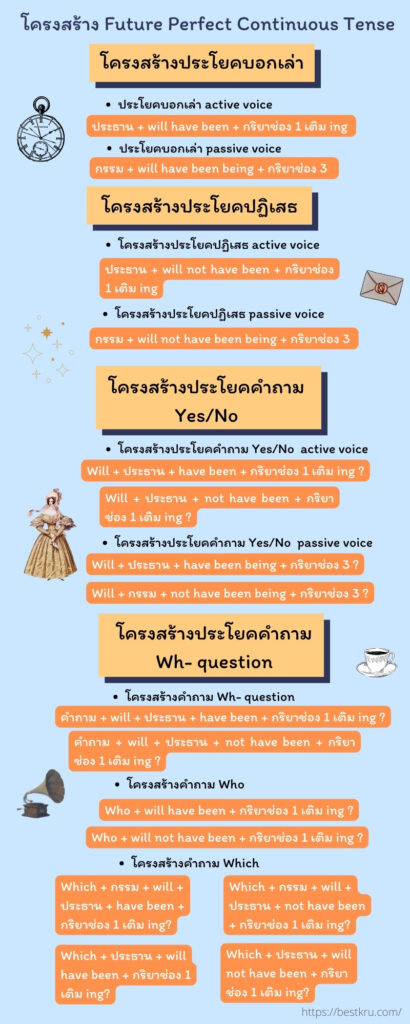
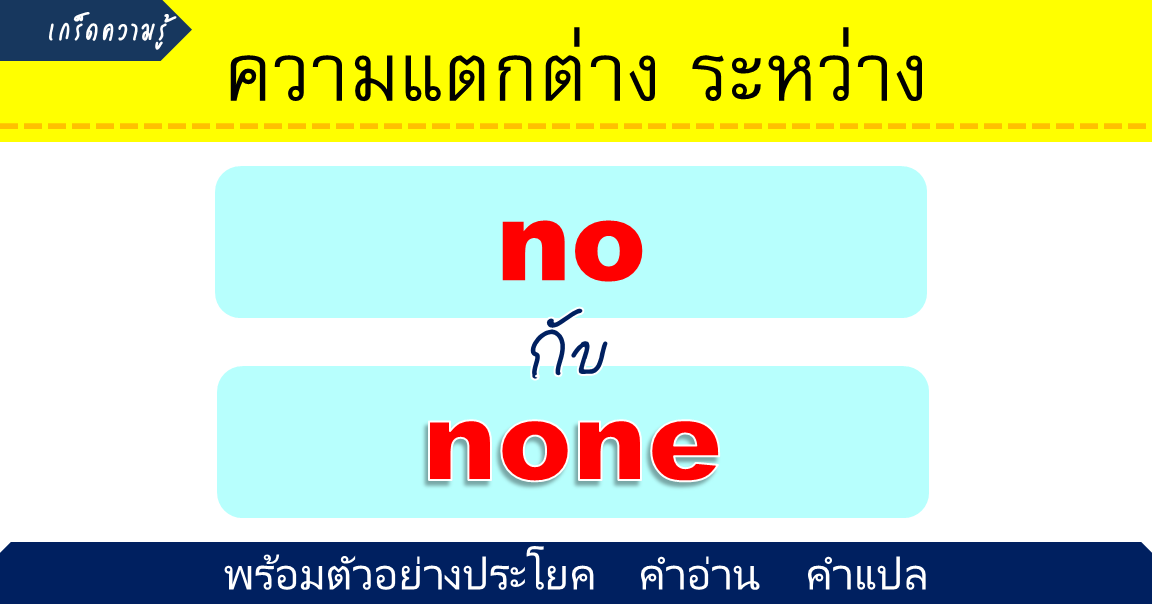
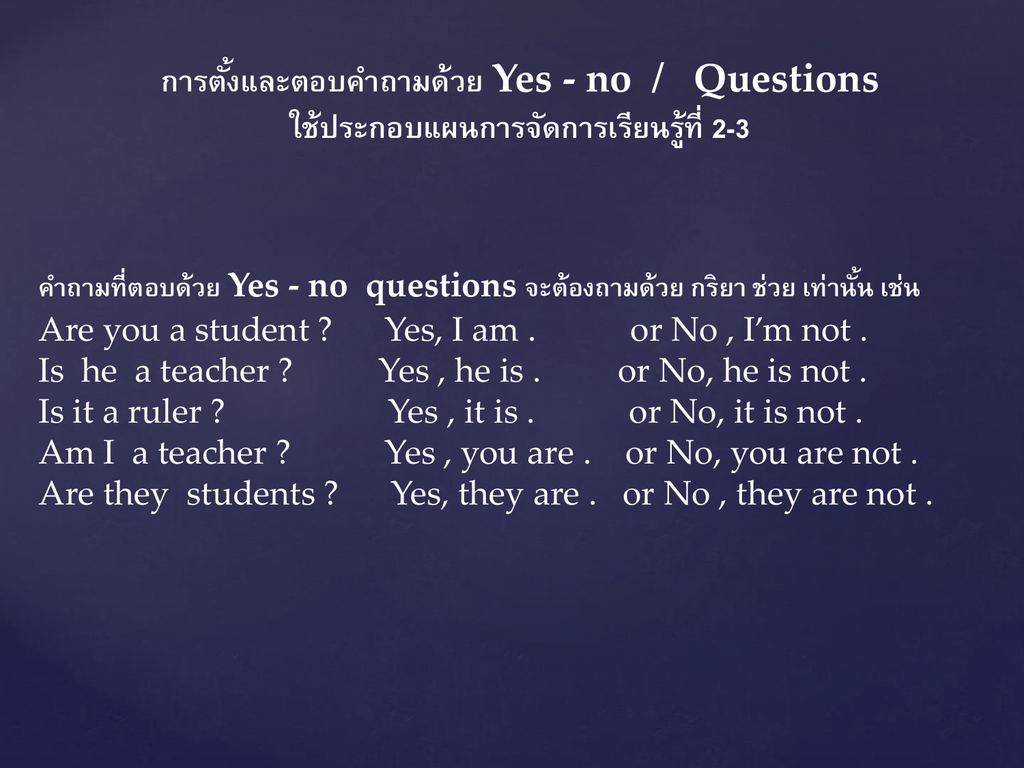

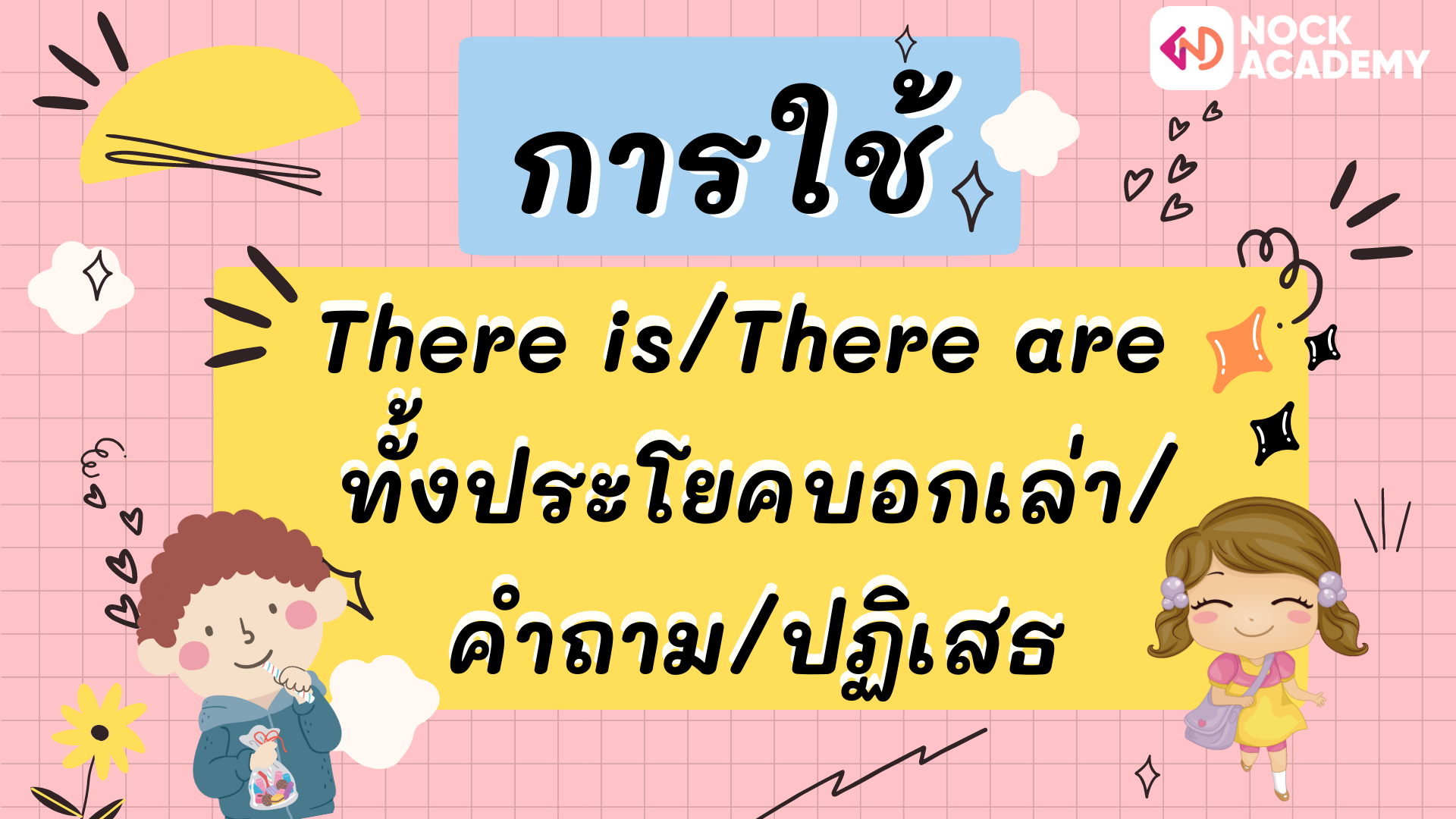



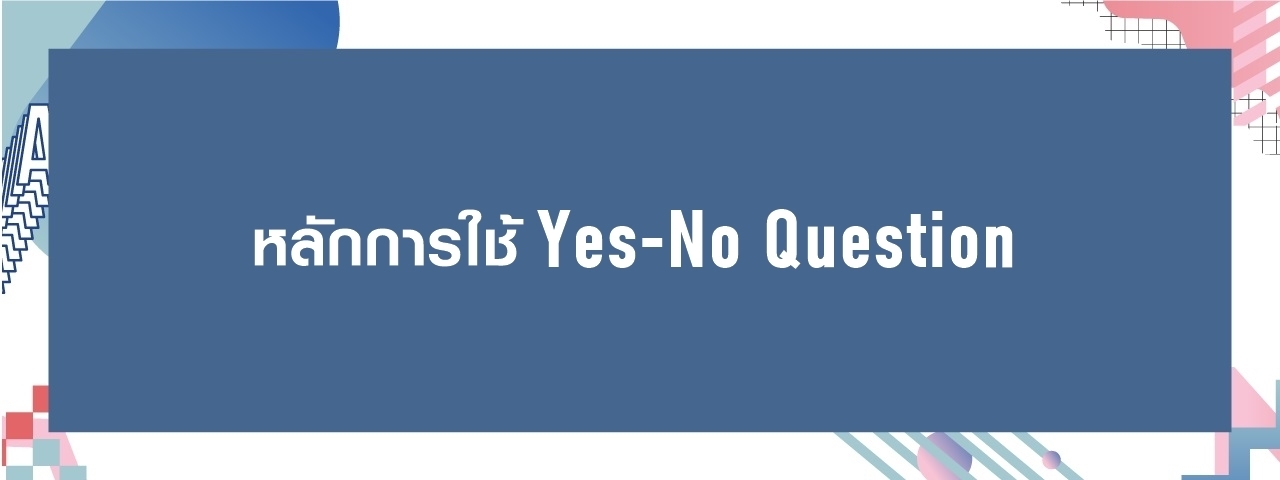


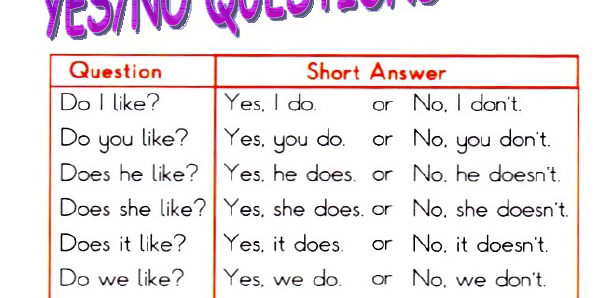




ลิงค์บทความ: การใช้ no not.
ดูข้อมูลเพิ่มเติมเกี่ยวกับโพสต์หัวข้อนี้ การใช้ no not.
- No กับ Not ใช้ต่างกันอย่างไร | Wall Street English Thailand
- Grammar: ความแตกต่างระหว่าง No กับ Not ใช้ต่างกันอย่างไร
- วิธีใช้ No กับ Not ในภาษาอังกฤษ ความเหมือนที่แตกต่าง ลองดูว่าเป็น …
- No และ Not ใช้ต่างกันอย่างไร โครงสร้างการใช้ ตัวอย่างประโยค ความ …
- No กับ Not ต่างกันอย่างไร ? – Engnow.in.th เรียนภาษาอังกฤษ …
- 3 ขั้นตอนสู่การใช้ “not” และ “no” อย่างแม่นยำ – Today’s English …
- No, Not, None ใช้ต่างกันอย่างไร – AjarnAdam
- เอาให้กระจ่าง! ระหว่าง no not non และ none มันต่างกันอย่างไร??
ดูเพิ่มเติม: https://phauthuatdoncam.net/tv-shows-a-z/